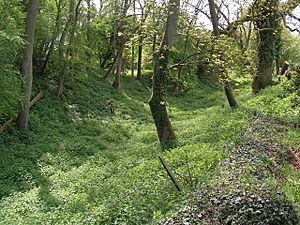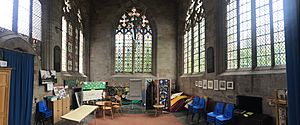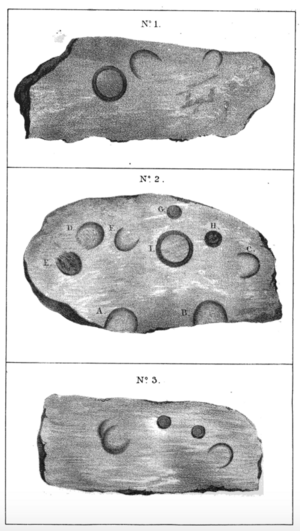Katherine of Ledbury facts for kids
Quick facts for kids Katherine of Ledbury |
|
|---|---|

St. Michael and All Angels Church in Ledbury, where Katherine lived as an anchoress or hermit.
|
|
| Anchoress, hermit | |
| Born | 1271 Brimpsfield, Gloucestershire, England |
| Residence | Ledbury, Herefordshire, England |
| Died | Sometime after 1326/7 |
| Major shrine | Possibly the Chapter House, St. Michael and All Angels Church, Ledbury, Herefordshire, England |
| Feast | 7 October (Diocese of Hereford); 25 November, derived from the earlier feast of Catherine of Alexandria |
| Attributes | ringing bells, the footprints of her stolen horse, clairvoyance, herbs and milk |
| Patronage | Ledbury, Herefordshire, England |
Katherine of Ledbury (born 1271) was a noblewoman from Gloucestershire, England, who lived in the 13th and 14th centuries. She became an anchoress in Ledbury, Herefordshire. An anchoress was a religious woman who chose to live a very strict life, often alone in a small room attached to a church, dedicating herself to prayer. Even though Katherine was never officially made a saint by the church, she is remembered as a special person in Ledbury. The famous poet William Wordsworth even wrote a sonnet about her. People sometimes confuse her with Catherine of Alexandria, an earlier saint from the 4th century.
Contents
Katherine's Early Life

Katherine was born in 1271 in Brimpsfield, Gloucestershire. Her father was John Giffard, 1st Baron Giffard, who owned Brimpsfield Castle. Her mother, Maud de Longspée, was a great-granddaughter of King John.
When Katherine was about 15 or 16 years old, in 1287 or 1288, she married Baron Nicholas de Audley. They had two sons and one daughter. Her first child was born when she was just 17.
In 1299, both her husband and her father passed away. This meant Katherine inherited a lot of land and property in different parts of England and Wales, including Carmarthenshire, Shropshire, Staffordshire, and Cheshire.
Becoming an Anchoress
After her husband and father died, Katherine decided to become an anchoress in Ledbury. Some stories say she disappeared on February 25, 1308, the day King Edward II was crowned. She later appeared in Ledbury as a recluse, which is another word for someone who lives alone and avoids others.
Historians believe Katherine might have become an anchoress to avoid getting married again. In those times, wealthy widows were often expected to remarry. Katherine was a very rich widow, so many lords would have wanted to marry her. By becoming an anchoress, she could choose her own path.
In 1308, Katherine arranged to give some of her inherited lands to her son, Nicholas. In return, he would pay her £100 each year to support her. This might have been her first step towards leaving the busy world behind.
It's not clear exactly where Katherine lived between her husband's death and her arrival in Ledbury. Some legends say she wandered, looking for a peaceful place. Others suggest she might have stayed at one of her properties before settling in Ledbury.
By 1313, Katherine was living in Ledbury. She gave more of her lands to her daughter and son-in-law. Sometime between 1313 and 1323, she officially began her life as an anchoress. In 1323, she was called a "recluse" in a legal document. This document gave her £30 a year from her husband's estate, which helped pay for her simple life as an anchoress.
Towards the end of her life, the money meant for Katherine was sometimes mismanaged or even stolen. This makes some historians wonder if she lived her final years in poverty, relying on help from the people of Ledbury.
Stories and Beliefs About Katherine
Legends of Katherine's Powers
People believed Katherine had special powers, like being able to see the future (clairvoyance) and having powerful prayers. One famous Ledbury legend says Katherine chose to come to Ledbury because a vision told her she must not stop traveling until she found a place where the church bells rang by themselves.
The story goes that Katherine and her maid, Mabel, followed the hoof-marks of Katherine's stolen horse from Worcestershire into Herefordshire. An old story collector named Jabez Allies wrote that Katherine prayed about the theft. After her prayer, the footprints of the thief and the horse's hoof-prints became deeply pressed into the earth and even into stones.
Jabez Allies even drew a picture of these marks, which he claimed to find in the sandstone rocks of Whelpley Brook. Locals called them the "tracks of St. Catherine's Mare and Colt." People also said the marks looked like loaves of bread that Saint Catherine used to give to the poor. For many years, these stones were used by local people as good luck charms against robbery. Even in the early 1800s, people still believed this story.
The legend continues that Katherine and Mabel reached a village called Bosbury. Katherine heard bells ringing and sent Mabel to find out why. Katherine believed she was meant to end her days in a place whose name ended with "bury." When Mabel returned and said the bells were ringing for a wedding, Katherine knew it wasn't the right place.
They continued their journey until they reached Ledbury. There, Katherine finally heard the church bells ringing on their own, without anyone ringing them. She decided to stay in Ledbury, living as an anchoress near the church. It is said she lived on a simple diet of herbs and milk. There was a stone, known as Katherine's Stone, where she was said to have been sitting when she heard the bells. This stone was visible for many years near the church.
Katherine's Special Place in Ledbury
Katherine was never officially declared a saint by the church, but people knew her as "a very good woman." Some people think that the Chapter House of St. Michael and All Angels Church in Ledbury was built as a special place for Katherine, perhaps hoping she would one day become a saint.
The Diocese of Hereford remembers Katherine on October 7th. This date is when Katherine gave away her properties to prepare for her life as a recluse. Some old books also mention a feast day for "St Catherine Audley" on November 25th. However, this is likely a mix-up with Saint Catherine of Alexandria, whose feast day is also November 25th.
Many historians believe that Katherine became known as a saint because people confused her with the earlier Saint Catherine. There was already a chapel, hospital, and almshouse (a place for the poor) in Ledbury named after Saint Catherine long before Katherine of Ledbury was born. It's even possible Katherine was named after the original Saint Catherine.
Historians point out that the lives of these two women became linked in people's minds. Saint Catherine of Alexandria's story was often used to teach young women who were thinking about joining a religious life. Since Katherine of Ledbury lived as an anchoress very close to the hospital named after Saint Catherine, it made the connection even stronger for the people of Ledbury.
See also
Images for kids







